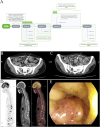Establishment and characterization of a sigmoid colon cancer organoid with spinal metastasis
- PMID: 39830210
- PMCID: PMC11739105
- DOI: 10.3389/fcell.2024.1510264
Establishment and characterization of a sigmoid colon cancer organoid with spinal metastasis
Abstract
Background: Sigmoid colon cancer with spinal metastases is rare in distant metastasis. In addition, the prognosis of colon cancer patients with spinal metastases is extremely poor. In order to find effective therapeutic agents, we need to know the biological characteristics of such patients from related models.
Methods: We collected sigmoid colon cancer tissue from a young female subject who was diagnosed with sigmoid colon cancer with multiple spinal metastases. We successfully established a sigmoid colon cancer organoid using this tissue and investigated drug screening in the patient. HE staining, immunohistochemistry, and DNA sequencing were utilized to compare the biological characteristics between the original tumor and the organoid. Furthermore, we investigated the drug screening of the sigmoid colon cancer organoid in vitro.
Results: A colon cancer organoid from sigmoid colon cancer with spinal metastases was successfully established. The organoid culture maintained the morphological features, histological features, and genomic landscape of the corresponding sigmoid colon cancer cells. Moreover, we performed drug screening tests to evaluate the effects of chemotherapeutic drugs and targeted drugs.
Conclusion: The sigmoid colon cancer organoid with spinal metastases was a favorable preclinical model to explore the clinicopathologic characteristics of colon cancer patients with spinal metastases.
Keywords: drug screening; genomic features; organoid culture; sigmoid colon cancer; spinal metastases.
Copyright © 2025 Chen, Cheng, Gu, Huang, Zhang, Sun and Chen.
Conflict of interest statement
The authors declare that the research was conducted in the absence of any commercial or financial relationships that could be construed as a potential conflict of interest.
Figures









Similar articles
-
Leiomyosarcoma of the sigmoid colon with multiple liver metastases and gastric cancer: a case report.BMC Gastroenterol. 2012 Jul 31;12:98. doi: 10.1186/1471-230X-12-98. BMC Gastroenterol. 2012. PMID: 22849696 Free PMC article.
-
Organoid models derived from patients with malignant phyllodes tumor of the breast.Breast Cancer Res Treat. 2023 Jul;200(2):193-201. doi: 10.1007/s10549-023-06973-5. Epub 2023 May 19. Breast Cancer Res Treat. 2023. PMID: 37204665
-
A novel human colon signet-ring cell carcinoma organoid line: establishment, characterization and application.Carcinogenesis. 2020 Jul 14;41(7):993-1004. doi: 10.1093/carcin/bgz178. Carcinogenesis. 2020. PMID: 31740922
-
Urethral metastasis from a sigmoid colon carcinoma: a quite rare case report and review of the literature.BMC Surg. 2014 May 21;14:31. doi: 10.1186/1471-2482-14-31. BMC Surg. 2014. PMID: 24884559 Free PMC article. Review.
-
Organoid culture to study epithelial cell differentiation and barrier formation in the colon: bridging the gap between monolayer cell culture and human subject research.In Vitro Cell Dev Biol Anim. 2021 Feb;57(2):174-190. doi: 10.1007/s11626-020-00534-6. Epub 2021 Jan 5. In Vitro Cell Dev Biol Anim. 2021. PMID: 33403624 Free PMC article. Review.
References
-
- Brannon A. R., Vakiani E., Sylvester B. E., Scott S. N., McDermott G., Shah R. H., et al. (2014). Comparative sequencing analysis reveals high genomic concordance between matched primary and metastatic colorectal cancer lesions. Genome Biol. 15 (8), 454. 10.1186/s13059-014-0454-7 - DOI - PMC - PubMed
LinkOut - more resources
Full Text Sources

